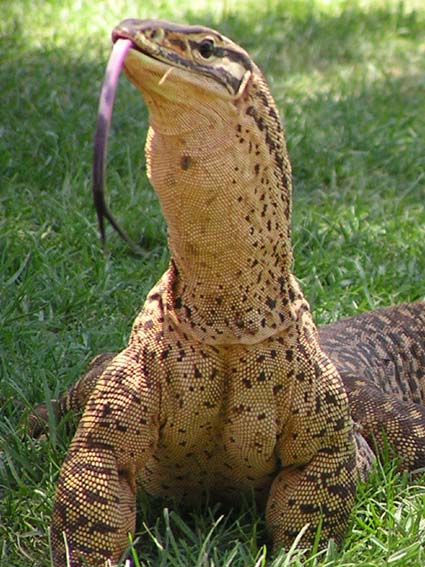
New Zealands Giant Enigmatic Lizards
There are 90 species of lizards currently known in New Zealand.
Most are not of any impressionable size and yet from Cooks first arrival in New Zealand,
strange tales of large lizards have been passed down to fairly recent times.

There were also reports however, given to the early European settlers of a 5-6 ft lizard which the Maori also hunt and ate.
In 1875 a strange lizard like animal had been found in a flooded river in Hokianga. The local Maori, out of fear of the animal, hacked it to pieces. From the same area emerged the reported sighting of an 18 inch lizard, yellowish in colour which slid down into the water when discovered and was lost among the boulders of the Hokianga River.
1875 also saw Mr F.W Hutton present a paper “On a Supposed Rib of the Kumi”. The paper spoke of the discovery of a ramus of the lower jaw of a pleurodont lizard from the Ernscleugh Cave in Central Otago. The ramus seemed to give foundation to the at least sub-fossil existence of the Kumi lizard. In the same cave a vertebral rib that also appeared to be from the same animal was found.
At the New Zealand Institute meeting of September 20th 1898 mention was made of a large, strange reptile allegedly seen near Gisborne. Furthermore, in September of that same year, in Arowhana, a bushman working on a station was confronted by a 5 ft long gigantic lizard which advanced toward him. The animal then subsequently fled into a Rata tree. Lysnar, the owner of the station where the animal was sighted, and a party of men went in search of the animal. They managed to photograph some footprints but did not come across the actual animal.
Another large lizard mentioned is referred to as the Ngarar. It is described as being bigger than a Tuatara, about 2-3 feet in length, was said to burrow, had a serrated dorsal crest and had prominent teeth which caused the upper lip to slightly project forward.There was also a smaller species of this lizard measuring around 18 inches in length, reminiscent of the animal seen at the Hokianga River. The larger species of Ngarar preferred the Manuka scrub, while the smaller species was to be found around streams and easily took to the water.
From what we can gather both the larger species seem to have been semi-arboreal, while the smaller appears to have preferred a semi amphibious lifestyle.From the size and habits of these lizards they would appear to be closely allied to the Varanus species of Lizards from Australia.With the diversity of lizards in New Zealand it would not be surprising to find the evolution of some form of Monitor Lizard in this country. Perhaps the fossil record still waits to be discovered, or even the animal itself in some remote bush area.If crocodiles could once live here, as supported by the find of a fragment of jawbone found in Otago, why not Monitor lizards of the sizes described.
